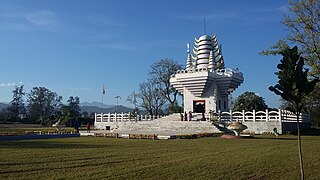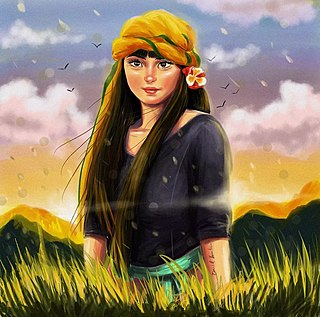
Lai Haraoba is a traditional Meitei religious festival of ritual dance and musical theatre, celebrated annually in honour of Umang Lais, the forest deities of Sanamahism.
Elam Endira Devi, is an Indian classical dancer and teacher, known for her expertise and scholarship in the classical dance form of Manipuri, especially in the genres of Lai Haraoba and Raas. The Government of India honored her, in 2014, with the Padma Shri, the fourth highest civilian award, for her services to the field of art and culture.
Khangembam Mangi Singh, popularly known as Guru Pena Mangi, was an Indian musician, known for his expertise on the Manipuri traditional musical instrument Pena. The Government of India honored him in 2011, with the fourth highest civilian award of Padma Shri.

Pena is a mono string instrument falling in the lute category, slightly similar to some of the traditional Indian stringed musical instruments such as the ravanahatha, ubo or the kenda. It is the traditional musical instrument of Manipur, used mainly in the Lai Haraoba festival of Sanamahism. Pena playing is becoming a dying art as only 145 active Pena players are reported in Manipur. The Center for Research on Traditional and Indigenous Art (Laihui), an organization headed by renowned pena player, Khangembam Mangi Singh has mandated vision to revive pena music.

Panthoibi, also known as Nongpok Leima, is a goddess associated with civilization, courage, fertility, handicraft, love, victory, warfare and wisdom in the mythology and religion of Ancient Kangleipak. She is a consort of the God Nongpok Ningthou. She is considered to be one of the divine incarnations of Leimarel Sidabi and is also identified as a form of Goddess Nongthang Leima. She is worshipped mainly by the Meitei people in Manipur, Assam, Tripura, Bangladesh and Myanmar.

Nongshaba is a lion god in Sanamahism and Meitei mythology. He is also regarded as a king of the gods. He is credited with producing light in the primordial universe and is regarded as the maker of the sun. He is worshipped by the people of both the Ningthouja clans as well as the Moirang clans. Nongshaba was worshipped by the people of Moirang clan as a lineage deity and regarded as the father of the god Thangching. He is the greatest of the Umang Lais but he made his only son Thangching the chief deity of Moirang.
The Khamba Thoibi Sheireng, also spelled as the Khamba Thoibi Seireng, is a Classical Meitei language epic poem based on the ancient love story of Khuman prince Khamba and Moirang princess Thoibi of Ancient Moirang kingdom of Ancient Kangleipak. It is the magnum opus of Hijam Anganghal, the "Bard of Samurou". It is regarded as the national epic of the Manipuris. It is regarded as the greatest of all the epic poems in Meitei literature, with 39,000 verses, thereby being the third longest Indian epic poem, next to the Mahabharata and the Ramayana.

Phou-oibi, the Rice Goddess is a 2013 Meitei language ballad opera, based on the story of goddess Phouoibi, adapted from Meitei mythology and folklore, performed by the Laihui Ensemble from Manipur, India, as a part of the "Tapestry of Sacred Music 2013" programme, held at the Esplanade in Singapore.

There are many different dance styles from Manipur, a state in northeastern India bordering with Myanmar (Burma), Assam, Nagaland and Mizoram. Manipuri dances encompasses both classical and folk dance forms. The Raas Leela is one of the major Indian classical dance forms. The folk dance forms are mainly attributed to ancient Meitei deities such as Umang Lai and performed during Lai Haraoba, and also the dances of the different tribal communities of Manipur.

Thangching or Thangjing is a primordial deity in Sanamahism, the indigenous religion of Manipur. He is the ruling deity of the Moirang dynasty. He rules supreme on the banks of the landlocked sea, Loktak lake. He is one of the four cardinal Umang Lais. The guardianship of the south western direction is alluded to Thangjing and the other directions to Koubru, Marjing and Wangbren.
Nura Pakhang is a Meitei-Portuguese bilingual music video. Its song was performed by Manipuri folk musical artist Mangka Mayanglambam and the artists of Portuguese musical band Clã. The music video is directed by Romi Meitei. It was released worldwide on 28 April 2017. It is a part of an album called "T(H)REE". It is a musical collaboration between Portuguese and Asian musicians in unique ways.
Shakuhachi meets Pena is a musical composition and performance, which is a collaboration of the performances of the traditional Japanese musical instrument Shakuhachi and the traditional Meitei musical instrument Pena. It is a maiden collaboration of traditional music between the two nations, India and Japan. It was performed by Motonaga Hiramu of Japan and Mayanglambam Mangangsana with his daughter Mangka Mayanglambam of Laihui, Imphal. It was performed at "The Giving Tree", Sangaiprou, Imphal West on 28 November 2016. It was performed on the last day of a 3 day workshop on Shakuhachi conducted as a part of the "Manipur Japan Summit 2016". It was organised by the "Laihui" in collaboration with the "Art Heals Trust, Imphal, Manipur" and the "The Japan Foundation, New Delhi".

Moirang Sai or Moirang Shai is a traditional Meitei musical performing art form, that narrates the story of Khamba and Thoibi. The performance timing can span over 120 hours.

The ancient legend of Khamba and Thoibi is a classic, as well as one of the epic cycles of incarnations of Meitei mythology and folklore, that is originated from Ancient Moirang kingdom of Ancient Kangleipak . It is referred to as the "National Romantic Legend of Manipur" by Padma Vibhushan awardee Indian scholar Suniti Kumar Chatterjee.

Khamba Thoibi Jagoi, also known as Khamba Thoibi classical dance or Khamba Thoibi ballet, is a traditional Meitei ritualistic and theatrical classical dance form, which is usually enacted as a part and parcel of the Lai Haraoba performances, dedicated to God Thangching, the national deity of Ancient Moirang realm. Notably, it is one of the cultural elements, giving inspirations to the development of the Manipuri Raas Leela classical dance drama form.

The culture of Meitei civilization evolved over thousands of years, beginning in Ancient Kangleipak, continuing most notably into Medieval Kangleipak, while influencing the neighboring states and kingdoms, till present times.

Jagoi refers to the arts of dance in Meitei culture.

Women have significant roles in different elements of Meitei culture, including Meitei dances, Meitei festivals, Meitei folklore, Meitei folktales, Meitei literature, Meitei mythology, Meitei religion, etc.

The cultural heritages of Meitei civilization has classicism in diverse traditions of cinemas, dances, language, literature, music, theatre, etc.

The intangible cultural heritage (ICH) of Meitei civilization is recognised, honoured, preserved as well as promoted by the UNESCO, the Ministry of Culture of the Union Government of India, the Government of Armenia, the State Government of Manipur, the State Government of Assam, the State Government of Tripura, among many other notable institutions.














